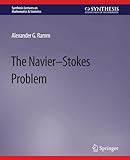The Navier-Stokes Problem [electronic resource] / by Alexander G. Ramm.
By: Ramm, Alexander G [author.] .
.
Contributor(s): SpringerLink (Online service) .
.
Material type:  BookSeries: Synthesis Lectures on Mathematics & Statistics: Publisher: Cham : Springer International Publishing : Imprint: Springer, 2021Edition: 1st ed. 2021.Description: XV, 61 p. online resource.Content type: text Media type: computer Carrier type: online resourceISBN: 9783031024313.Subject(s): Mathematics
BookSeries: Synthesis Lectures on Mathematics & Statistics: Publisher: Cham : Springer International Publishing : Imprint: Springer, 2021Edition: 1st ed. 2021.Description: XV, 61 p. online resource.Content type: text Media type: computer Carrier type: online resourceISBN: 9783031024313.Subject(s): MathematicsPreface -- Introduction -- Brief History of the Navier-Stokes Problem -- Statement of the Navier-Stokes Problem -- Theory of Some Hyper-Singular Integral Equations -- A Priori Estimates of the Solution to the NSP -- Uniqueness of the Solution to the NSP -- The Paradox and its Consequences -- Logical Analysis of Our Proof -- Appendix 1 - Theory of Distributions and Hyper-Singular Integrals -- Appendix 2 - Gamma and Beta Functions -- Appendix 3 - The Laplace Transform -- Bibliography -- Author's Biography.
The main result of this book is a proof of the contradictory nature of the Navier‒Stokes problem (NSP). It is proved that the NSP is physically wrong, and the solution to the NSP does not exist on ℝ+ (except for the case when the initial velocity and the exterior force are both equal to zero; in this case, the solution ����(����, ����) to the NSP exists for all ���� ≥ 0 and ����(����, ����) = 0). It is shown that if the initial data ����0(����) ≢ 0, ����(����,����) = 0 and the solution to the NSP exists for all ���� ϵ ℝ+, then ����0(����) := ����(����, 0) = 0. This Paradox proves that the NSP is physically incorrect and mathematically unsolvable, in general. Uniqueness of the solution to the NSP in the space ����21(ℝ3) × C(ℝ+) is proved, ����21(ℝ3) is the Sobolev space, ℝ+ = [0, ∞). Theory of integral equations and inequalities with hyper-singular kernels is developed. The NSP is reduced to an integral inequality with a hyper-singular kernel.


There are no comments for this item.